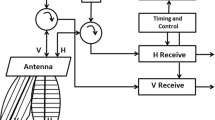Abstract
In this paper, model-based (surface, dihedral and volume scattering) target decomposition technique is proposed to decompose the π/4 mode compact polarimetric radar data. A general relationship between fully polarimetric coherence matrix and the Stokes vector of the π/4 mode compact polarimetric data is first established. Based on the Stokes vector, a proposed algorithm to retrieve the power of three scattering mechanisms is given in details. We validate this algorithm with L-band AIRSAR, San Francisco Bay, and results of decomposition are discussed and assessed in detail by being compared with the quad-pol Freeman-Durden decomposition results. Finally, the π/4 mode decomposition is compared with the CTLR (circular transmitting and linear reeving) mode, and with the π/4 mode m − δ targets decomposition. The comparison results are analyzed and discussed in detail.
创新点
本文中,将基于模型的目标分解方法应用到 π/4 模式简缩极化数据中。首先推导出全极化相干矩阵与π/4 模式简缩极化斯托克斯矢量之间一般关系表达式。获得体散射和秩为1的单一散射机制的简缩极化斯托克斯矢量表达式,建立RVoG模型的斯托克斯矢量形式。基于该RVoG矢量形式推导出详细的目标分解方法。运用L波段AirSAR 旧金山数据验证该目标分解方法,并且与全极化目标分解结果进行对比分析。最后,对比分析π/4 模式与CTLR模式分解结果,以及π/4 模式下基于模型的目标分解方法与传统m-δ 分解对比结果。
Similar content being viewed by others
References
Chen L. Investigation on models and methods of compact polarimetric SAR information processing. Dissertation for Ph.D. Degree. Beijing: Institute of Electronics, Chinese Academy of Sciences, 2013. 2–3
Souyris J C, Imbo P, Fjortoft R, et al. Compact polarimetry based on symmetry properties of geophysical media: the π/4 mode. IEEE Trans Geosci Rem Sens, 2005, 43: 634–646
Raney R. Hybrid-polarity sar architecture. IEEE Trans Geosci Rem Sens, 2007, 45: 3397–3404
Collins M J, Denbina M, Atteia G. On the reconstruction of quad-pol SAR data from compact polarimetry data for ocean target detection. IEEE Trans Geosci Rem Sens, 2013, 51: 591–600
Nord M, Ainsworth T, Lee J S, et al. Comparison of compact polarimetric synthetic aperture radar modes. IEEE Trans Geosci Rem Sens, 2009, 47: 174–188
Li H Y, Perrie W, He Y J, et al. Target detection on the ocean with the relative phase of compact polarimetry SAR. IEEE Trans Geosci Rem Sens, 2013, 51: 3299–3305
Charbonneau F J, Brisco B, Raney R K, et al. Compact polarimetry overview and applications assessment. Can J Rem Sens, 2010, 36, 298–315
Ballester-Berman J D, Lopez-Sanchez J M. Analysis on the potential of L-band polsar data for crop monitoring. In: Proceedings of ESA Internal Workshop on POLInSAR, Frascati, 2011
Lee J S, Poitter E. Polarimetric Radar Imaging: From Basics to Applications. Boca Raton: CRC Press, Taylor & Francis Group, 2009. 49–51
Raney R. Dual-polarized sar and stokes parameters. IEEE Trans Geosci Rem Sens, 2006, 3: 317–319
Freeman A, Durden S. A three-component scattering model for polarimetric sar data. IEEE Trans Geosci Rem Sens, 1998, 36: 963–973
Cloude S, Pottier E. A review of target decomposition theorems in radar polarimetry. IEEE Trans Geosci Rem Sens, 1996, 34: 498–518
Liu T, Huang G M, Wang X S, et al. Statistical assessment of H/A target decomposition theorems in radar polarimetry. Sci China Inf Sci, 2010, 53: 355–366
Cloude S. Polarisation: Applications in Remote Sensing. London: Oxford Univ Press, 2009. 142–158
Cloude S, Goodenough D, Chen H. Compact decomposition theory. IEEE Geosci Rem Sens Lett, 2012, 9: 28–32
López-Martinez C, Alonso-González A. Assessment and estimation of the RVoG model in polarimetric SAR interferometry. IEEE Trans Geosci Rem Sens, 2014, 52: 3091–3106
Huynen J R. Stokes matrix parameters and their interpretation in terms of physical target properties. In: Proceedings of International Society for Optics and Photonics, Orlando, 1990. 195–207
Author information
Authors and Affiliations
Corresponding author
Rights and permissions
About this article
Cite this article
Guo, S., Li, Y., Hong, W. et al. Model-based target decomposition with the π/4 mode compact polarimetry data. Sci. China Inf. Sci. 59, 062307 (2016). https://doi.org/10.1007/s11432-015-5478-4
Received:
Accepted:
Published:
DOI: https://doi.org/10.1007/s11432-015-5478-4




